Analysis of the Importance of the Motion Used in the Resistance of Different Mechanical Instrumentation Systems in Endodontics: A Comparative Study
Abstract
:1. Introduction
2. Materials and Methods
2.1. Study Design
2.2. The Experimental Cyclic Fatigue Model
2.3. Statistical Tests
3. Results
4. Discussion
5. Conclusions
Author Contributions
Funding
Institutional Review Board Statement
Informed Consent Statement
Data Availability Statement
Acknowledgments
Conflicts of Interest
References
- Huffaker, S.K.; Safavi, K.; Spangberg, L.; Kaufman, B. Influence of a passive sonic irrigation system on the elimination of bacteria from root canal systems: A clinical study. J. Endod. 2010, 36, 1315–1318. [Google Scholar] [CrossRef] [PubMed]
- Brito, P.; Souza, L.; Machado de Oliveira, J.C.; Alves, F.; De-Deus, G.; Lopes, H.P.; Siqueira, J.F., Jr. Comparison of the effectiviness of three irrigation techniques in reducing intracanal Enterococcus faecalis populations: An in vitro study. J. Endod. 2009, 35, 1422–1427. [Google Scholar] [CrossRef] [PubMed]
- Caron, G.; Nham, K.; Bronnec, F.; Machtou, P. Effectiviness of different final irrigant activation on smear layer removal in curved canals. J. Endod. 2010, 836, 1361–1366. [Google Scholar] [CrossRef] [PubMed]
- Pasqualini, D.; Cuffini, A.M.; Scotti, N.; Mandras, N.; Scalas, D.; Pera, F.; Berutti, E. Comparative evaluation of the antimicrobial efficacy of a 5% sodium hypochlorite subsonic-activates solution. J. Endod. 2010, 36, 1358–1360. [Google Scholar] [CrossRef]
- Peters, O.A. Current challenges and concepts in the preparation of root canal systems: A review. J. Endod. 2004, 30, 559–567. [Google Scholar] [CrossRef] [PubMed] [Green Version]
- Schilder, H.; Hargreaves, K.M. Filling root canals in three dimensions. J. Endod. 2006, 3, 281–290. [Google Scholar] [CrossRef]
- Kulkarni, G.; Balakrishnan, R.; Shetty, H.H.K.; Praveena, G. A Quantitative Evaluation of the Sealing Ability of Three Different Obturation Techniques Using the Glucose Leakage Test: An In Vitro Study. J. Int. Oral Health 2016, 8, 787–794. [Google Scholar]
- Pommel, L.; Camps, J. In Vitro Apical Leakage of System B Compared with Other Filling Techniques. J. Endod. 2001, 27, 449–451. [Google Scholar] [CrossRef]
- Peng, L.; Ye, L.; Tan, H.; Zhou, X. Outcome of root canal obturation by warm gutta-percha versus cold lateral condensation: A meta-analysis. J. Endod. 2007, 33, 106–109. [Google Scholar] [CrossRef]
- Zhang, E.; Cheung, G.; Zheng, Y. Influence of cross-sectional design and dimension on mechanical behavior of nickel-ti-tanium instruments under torsion and bending: A numerical analysis. J. Endod. 2010, 36, 1394–1398. [Google Scholar] [CrossRef]
- McSpadden, J.T. Mastering Endodontic Instrumentation; Cloudland Institute: Chattanooga, TN, USA, 2007. [Google Scholar]
- Chaves Craveiro de Melo, M.; Guiomar de Azevedo Bahia, M.; Lopes Buono, V.T. Fatigue resistan ce of engine-driven rotary nickel-titanium endodontic instruments. J. Endod. 2002, 28, 765–769. [Google Scholar] [PubMed]
- Thompson, S.A. An overview of nickel-titanium alloys used in dentistry. Int. Endod. J. 2000, 33, 297–310. [Google Scholar] [CrossRef] [PubMed] [Green Version]
- Cheung, G.S.P.; Peng, B.; Bian, Z.; Shen, Y.; Darvell, B.W. Defects in ProTaper S1 instruments after clinical use: Fractographic examination. Int. Endod. J. 2005, 38, 802–809. [Google Scholar] [CrossRef] [PubMed]
- Di Nardo, D.; Morese, A.; Ferri, V.; Obino, F.V.; Seracchiani, M.; Testarelli, L. Effect of heat treatment on the cyclic fatigue resistance of NiTi endodontic openers. Ann. Stomatol. 2018, 9, 24–26. [Google Scholar]
- Martins, J.N.R.; Silva, E.J.N.L.; Marques, D.; Pereira, M.R.; Vieira, V.T.L.; Arantes-Oliveira, S.; Martins, R.F.; Braz Fernandes, F.; Versiani, M. Design, Metallurgical Features, and Mechanical Behaviour of NiTi Endodontic Instruments from Five Different Heat-Treated Rotary Systems. Materials 2022, 15, 1009. [Google Scholar] [CrossRef]
- Testarelli, L.; Plotino, G.; Al-Sudani, D.; Vincenzi, V.; Giansiracusa, A.; Grande, N.M.; Gambarini, G. Bending properties of a new nickel-titanium alloy with a lower percent by weight of nickel. J. Endod. 2011, 37, 1293–1295. [Google Scholar] [CrossRef]
- Pérez-Higueras, J.J.; Arias, A.; de la Macorra, J.C.; Peters, O.A. Differences in cyclic fatigue resistance between ProTaper Next and ProTaper Universal instruments at different levels. J. Endod. 2014, 40, 1477–1481. [Google Scholar] [CrossRef]
- Kimura, S.; Ebihara, A.; Maki, K.; Nishijo, M. Effect of Optimum Torque Reverse Motion on Torque and Force Generation during Root Canal Instrumentation with Crown-down and Single-length Techniques. J. Endod. 2020, 46, 232–237. [Google Scholar] [CrossRef]
- Lee, J.Y.; Kwak, S.W.; Ha, J.; Kim, H. Ex-Vivo Comparison of Torsional Stress on Nickel–Titanium Instruments Activated by Continuous Rotation or Adaptive Motion. Materials 2020, 13, 1900. [Google Scholar] [CrossRef] [Green Version]
- Zubizarreta-Macho, A.; Albadalejo Martínez, A.; Falcao Costa, C.; Quispe López, N.; Agustín-Panadero, R.; Mena Álvarez, J. Influence of the type of reciprocating motion on the cyclic fatigue resistance of reciprocating files in a dynamic model. BMC Oral Health 2021, 21, 179. [Google Scholar] [CrossRef]
- Zubizarreta-Macho, A.; Mena Álvarez, J.; Albadalejo Martínez, A.; Segura-Egea, J.J.; Caviedes Brucheli, J.; López Píriz, R.; Alonso-Ezpeleta, O. Infuence of the pecking motion on the cyclic fatigue resistance of endodontic rotary fles. J. Clin. Med. 2019, 9, 45. [Google Scholar] [CrossRef] [PubMed] [Green Version]
- Sattapan, B.; Nervo, G.J.; Palamara, J.E.A.; Meser, H.H. Defects in rotary Nickel titanium files after clinical use. J. Endod. 2000, 26, 161–165. [Google Scholar] [CrossRef] [PubMed] [Green Version]
- Plotino, G.; Grande, N.M.; Melo, M.C.; Bahia, M.G.; Testarelli, L.; Gambarini, G. Cyclic fatigue of NiTi rotary instruments in a simulated apical abrupt curvature. Int. Endod. J. 2010, 43, 226–230. [Google Scholar] [CrossRef] [PubMed]
- Pruett, J.P.; Clement, D.; Carnes, D. Cyclic fatigue testing of nickel-titanium endodontic instruments. J. Endod. 1997, 23, 77–85. [Google Scholar] [CrossRef]
- Topçuoğlu, H.S.; Topçuoğlu, G.; Kafdağ, Ö.; Arslan, H. Cyclic fatigue resistance of new reciprocating glide path files in 45- and 60-degree curved canals. Int. Endod. J. 2018, 51, 1053–1058. [Google Scholar] [CrossRef]
- Aminsobhani, M.; Meraji, N.; Sadri, E. Comparison of Cyclic Fatigue Resistance of Five.Nickel Titanium Rotary File Systems with Different Manufacturing Techniques. J. Dent. (Tehran) 2015, 12, 636–646. [Google Scholar]
- Martins, J.N.R.; Silva, E.J.N.L.; Marques, D.; Belladonna, F.; Simões-Carvalho, M.; Vieira, V.T.L.; Antunes, H.S.; Braz Fernandes, F.M.B.; Versiani, M.A. Design, metallurgical features, mechanical performance and canal preparation of six reciprocating instruments. Int. Endod. J. 2021, 54, 1623–1637. [Google Scholar] [CrossRef]
- Zupanc, J.; Vahdat-Pajouh, N.; Schäfer, E. New thermomechanically treated NiTi alloys—A review. Int. Endod. J. 2018, 51, 1088–1103. [Google Scholar] [CrossRef] [Green Version]
- Ruiz-Sánchez, C.; Faus-Llácer, V.; Faus-Matoses, I.; Zubizarreta-Macho, Á.; Sauro, S.; Faus-Matoses, V. The Influence of NiTi Alloy on the Cyclic Fatigue Resistance of Endodontic Files. J. Clin. Med. 2020, 9, 3755. [Google Scholar] [CrossRef]
- Almeida, G.C.; Guimarães, L.C.; Resende, P.D.; Buono, V.T.L.; Peixoto, I.F.C.; Viana, A.C.D. Torsional behaviour of Reciproc and Reciproc blue instruments associated with their martensitic transformation temperatures. Int. Endod. J. 2019, 52, 1768–1772. [Google Scholar]
- Scott, R.; Arias, A.; Macorra, J.C.; Govindjee, S.; Peters, O.A. Resistance to cyclic fatigue of reciprocating instruments determined at body temperature and phase transformation analysis. Aust. Endod. J. 2019, 45, 400–406. [Google Scholar] [CrossRef] [PubMed]
- Al-Obaida, M.I.; Merdad, K.; Alanazi, M.S.; Altwaijry, H.; AlFaraj, M.; Alkhamis, A.A.; Al-Madi, E.M. Comparison of cyclic fatigue resistance of 5 heat-treated nickel-titanium reciprocating systems in canals with single and double curvatures. J. Endod. 2019, 45, 1237–1241. [Google Scholar] [CrossRef] [PubMed]
- Keskin, C.; Inan, U.; Demiral, M. Cyclic Fatigue Resistance of Reciproc Blue, Reciproc, and WaveOne Gold Reciprocating Instruments. J. Endod. 2017, 43, 1360–1363. [Google Scholar] [CrossRef]
- Arias, A.; Perez-Higueras, J.J.; de la Macorra, J.C. Differences in cyclic fatigue resistance at apical and coronal levels of Reciproc and WaveOne new files. J. Endod. 2012, 38, 1244–1248. [Google Scholar] [CrossRef] [PubMed] [Green Version]
- Grande, N.M.; Plotino, G.; Pecci, R.; Bedini, R.; Malagnino, V.A.; Somma, F. Cyclic fatigue resistance and three dimensional analysis of instruments from two nickel–titanium rotary systems. Int. Endod. J. 2006, 39, 755–763. [Google Scholar] [CrossRef]
- Di Nardo, D.; Galli, M.; Morese, A.; Seracchiani, M.; Ferri, V.; Miccoli, G.; Gambarini, G.; Testarelli, L. A comparative study of mechanical resistance of two reciprocating files. J. Clin. Exp. Dent. 2019, 11, e231–e235. [Google Scholar] [CrossRef]
- Rodrigues, R.C.V.; Lopes, P.; Elias, C.N.; Amaral, G.; Vieira, V.T.L.; Martin, A.S.D. Influence of Different Manufacturing Methods on the Cyclic Fatigue of Rotary Nickel-Titanium Endodontic Instruments. J. Endod. 2011, 37, 1553–1557. [Google Scholar] [CrossRef]
- Pedullà, E.; Grande, N.M.; Plotino, G.; Gambarini, G.; Rapisarda, E. Influence of continuous or reciprocating motion on cyclic fatigue resistance of 4 different nickel-titanium rotary instruments. J. Endod. 2013, 39, 258–261. [Google Scholar] [CrossRef]
- Adıgüzel, M.; Capar, I.D. Comparison of Cyclic Fatigue Resistance of WaveOne and WaveOne Gold Small, Primary, and Large Instruments. J. Endod. 2017, 43, 623–627. [Google Scholar] [CrossRef]
- Vadhana, S.; Saravanakarthikeyan, B.; Nandini, S.; Velmurugan, N. Cyclic fatigue resistance of RaCe and Mtwo rotary files in continuous rotation and reciprocating motion. J. Endod. 2014, 40, 995–999. [Google Scholar] [CrossRef]
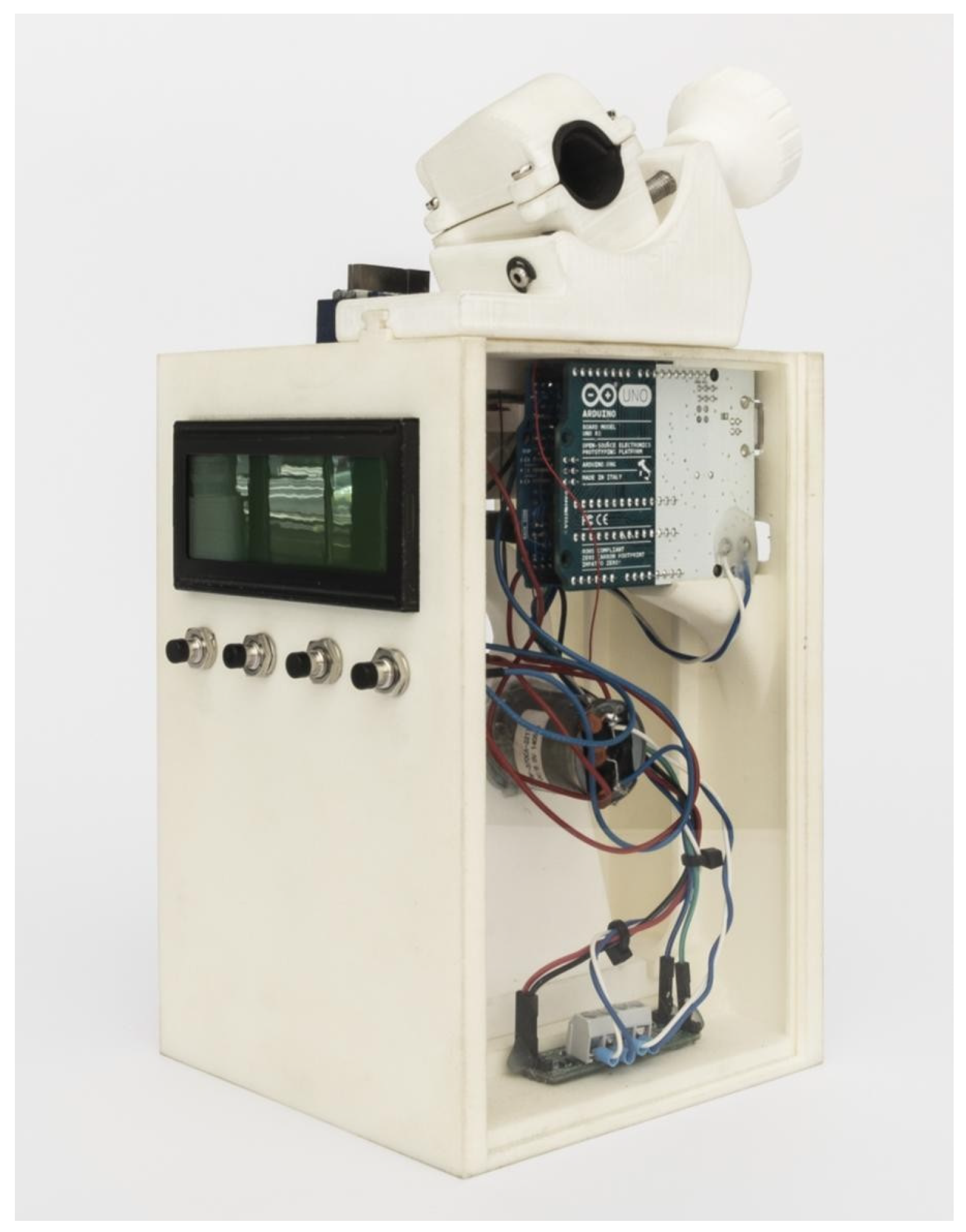
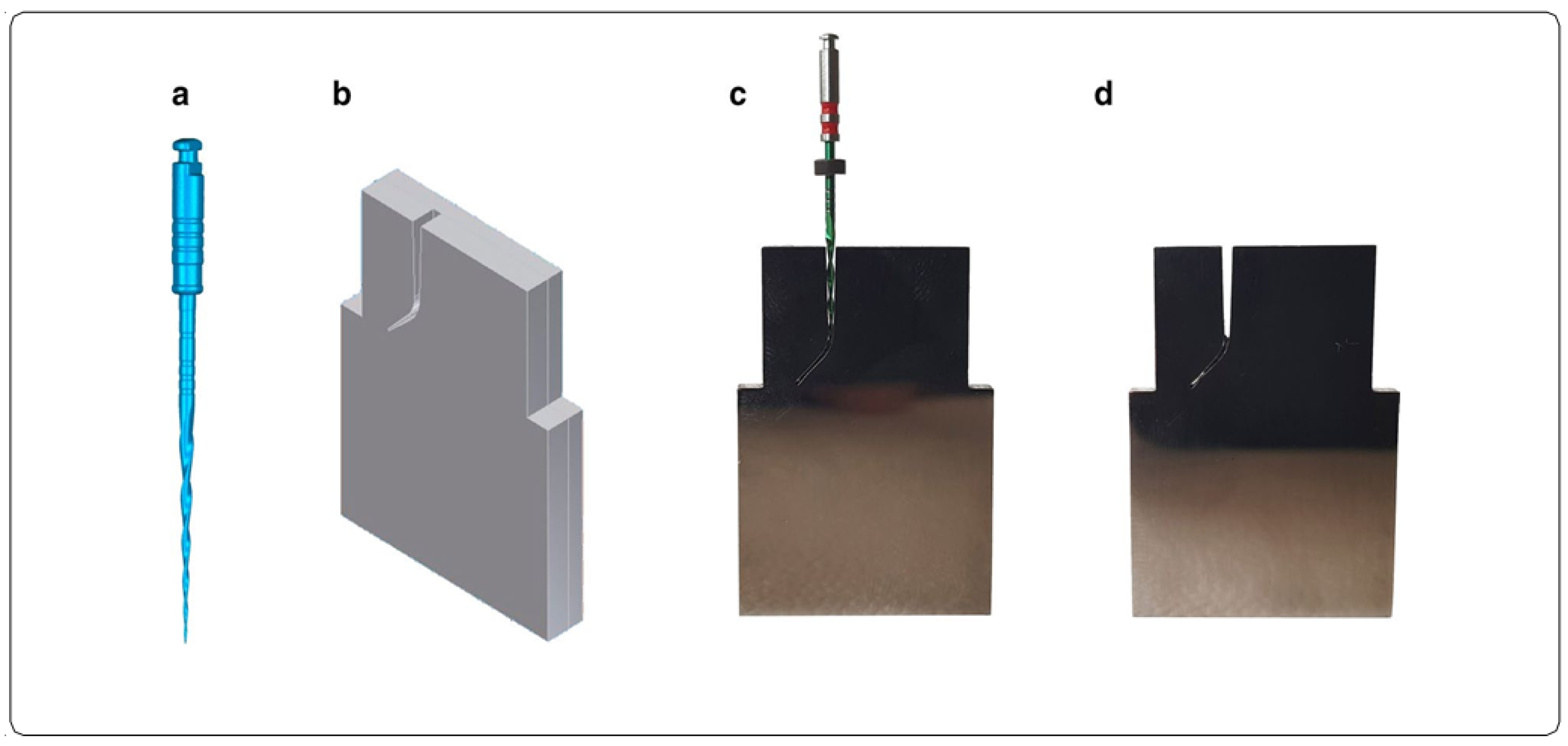
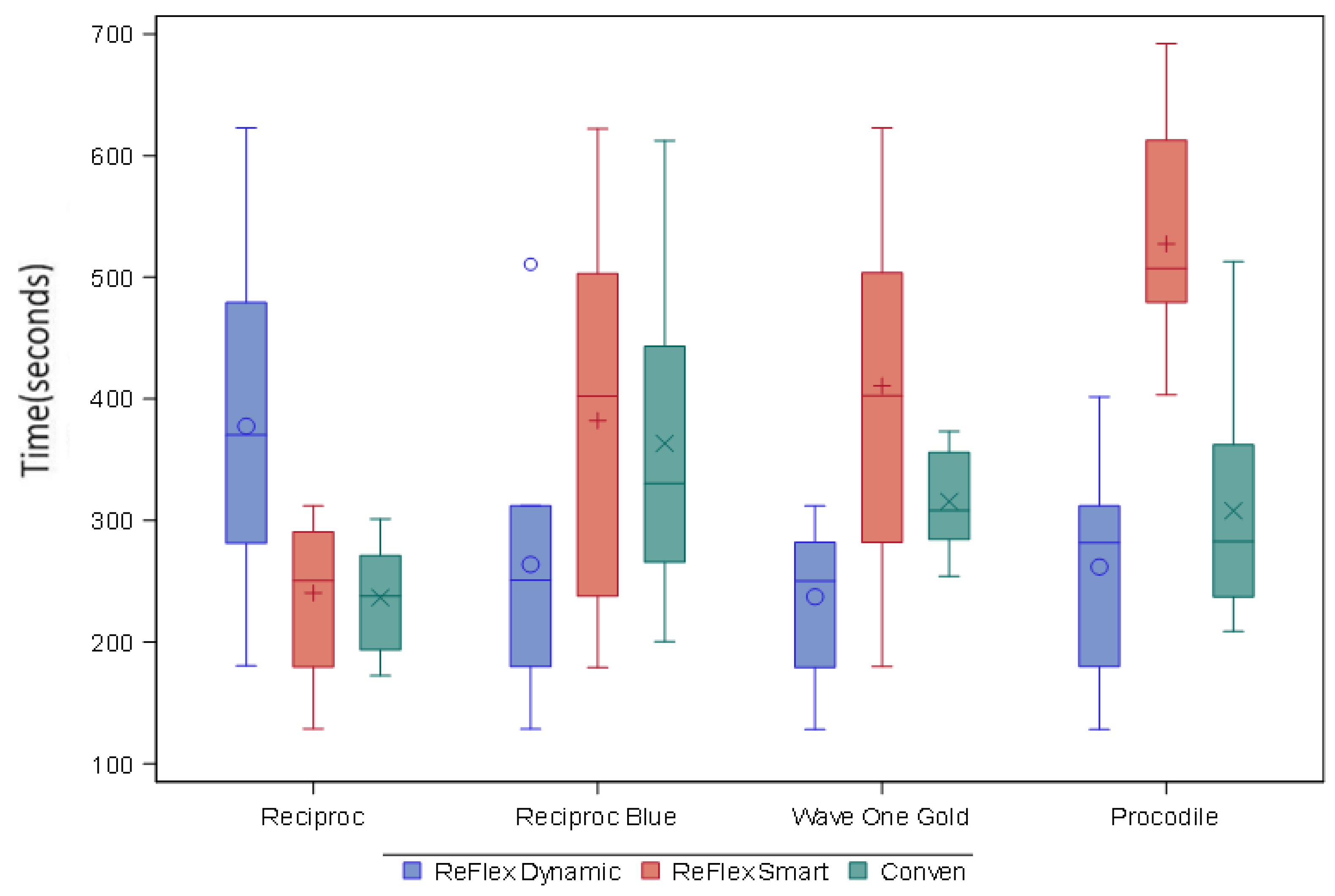

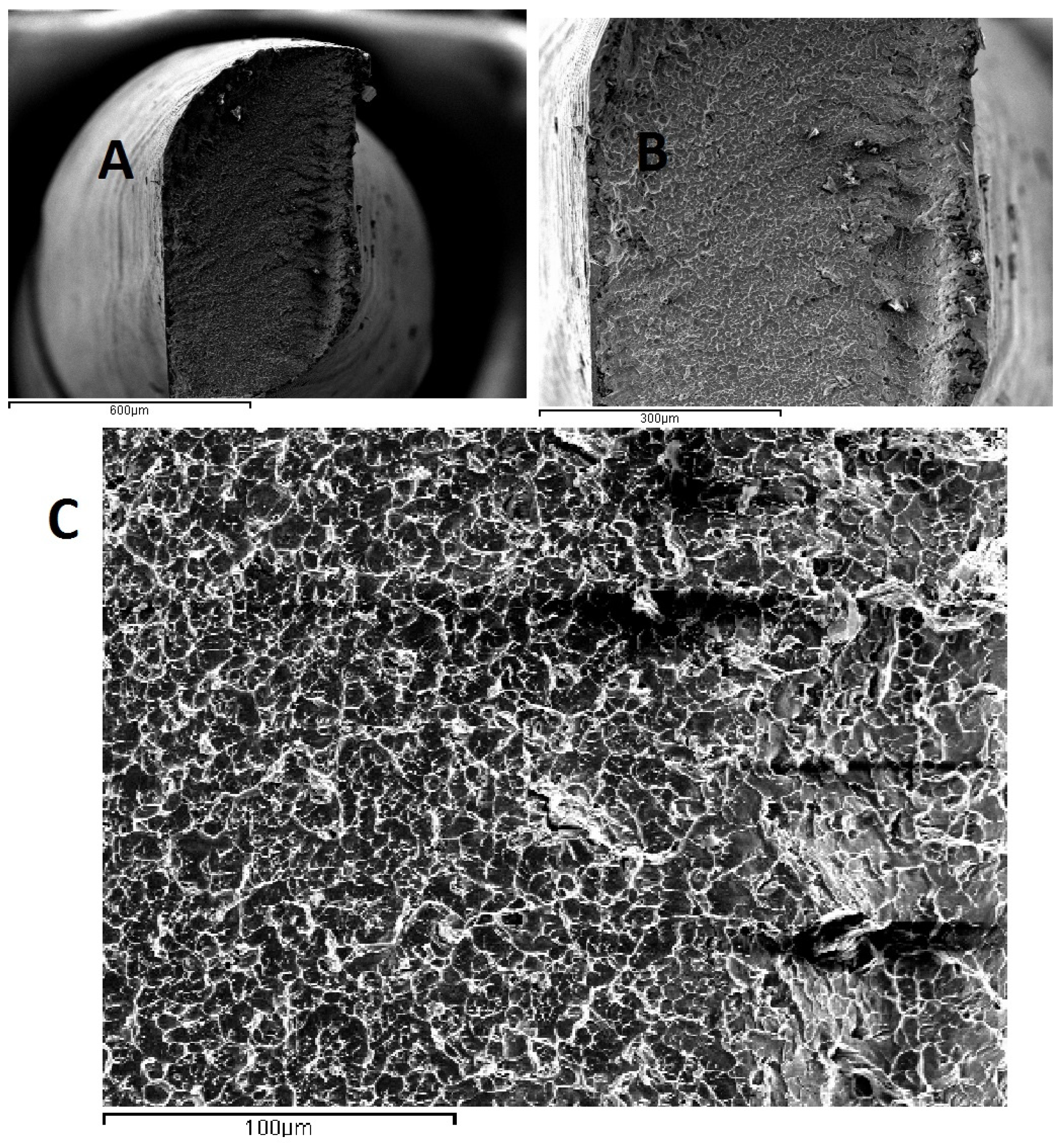
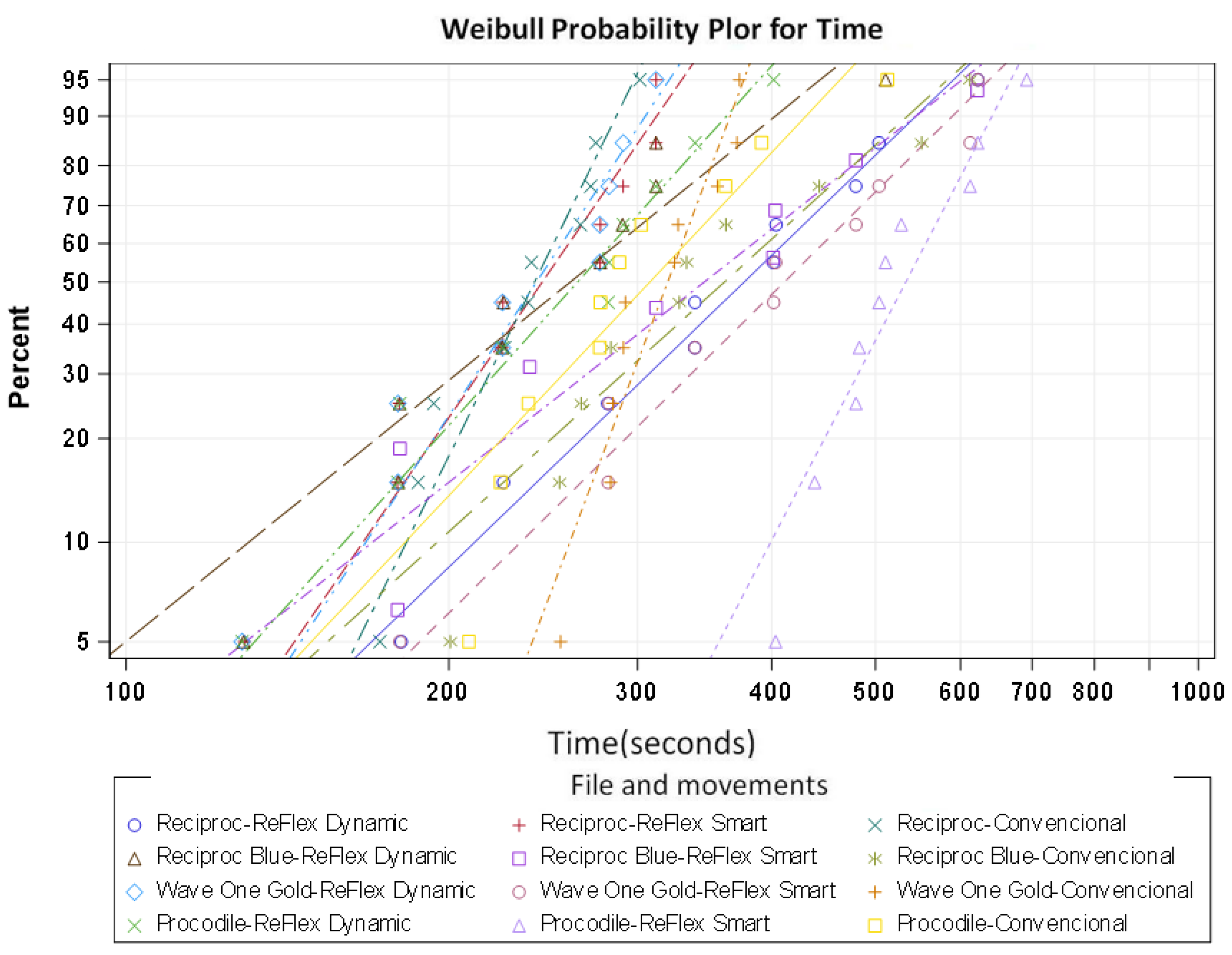
| File | F Value | p-Value | |
|---|---|---|---|
| Reciproc | 6.15 | 0.0029 | * |
| Reciproc Blue | 3.86 | 0.0240 | * |
| Wave One Gold | 7.19 | 0.0012 | * |
| Procodile | 19.22 | <0.001 | * |
| File | Movement | Movement | p-Value | |
|---|---|---|---|---|
| Reciproc | ReFlex Dynamic | ReFlex Smart | 0.0094 | * |
| ReFlex Dynamic | Conventional | 0.0074 | * | |
| ReFlex Smart | Conventional | 0.9961 | ||
| Reciproc Blue | ReFlex Dynamic | ReFlex Smart | 0.0296 | * |
| ReFlex Dynamic | Conventional | 0.0801 | ||
| ReFlex Smart | Conventional | 0.9118 | ||
| Wave One Gold | ReFlex Dynamic | ReFlex Smart | 0.0007 | * |
| ReFlex Dynamic | Conventional | 0.2051 | ||
| ReFlex Smart | Conventional | 0.1000 | ||
| Procodile | ReFlex Dynamic | ReFlex Smart | <0.001 | * |
| ReFlex Dynamic | Conventional | 0.5734 | ||
| ReFlex Smart | Conventional | <0.001 | * |
| Movement | F Value | p-Value | |
|---|---|---|---|
| ReFlex Dynamic | 3.76 | 0.0129 | * |
| ReFlex Smart | 13.28 | <0.001 | * |
| Conventional | 2.61 | 0.0550 |
| Movement | Type of File | Type of File | p-Value | |
|---|---|---|---|---|
| ReFlex Dynamic | Reciproc | Reciproc Blue | 0.0682 | |
| Reciproc | Wave One Gold | 0.0144 | * | |
| Reciproc | Procodile | 0.0614 | ||
| Reciproc Blue | Wave One Gold | 0.9377 | ||
| Reciproc Blue | Procodile | 1.0000 | ||
| Wave One Gold | Procodile | 0.9497 | ||
| ReFlex Smart | Reciproc | Reciproc Blue | 0.0131 | * |
| Reciproc | Wave One Gold | 0.0018 | * | |
| Reciproc | Procodile | <0.001 | * | |
| Reciproc Blue | Wave One Gold | 0.9249 | ||
| Reciproc Blue | Procodile | 0.0104 | * | |
| Wave One Gold | Procodile | 0.0577 | ||
| Conventional | Reciproc | Reciproc Blue | 0.0329 | * |
| Reciproc | Wave One Gold | 0.3145 | ||
| Reciproc | Procodile | 0.4057 | ||
| Reciproc Blue | Wave One Gold | 0.7245 | ||
| Reciproc Blue | Procodile | 0.6215 | ||
| Wave One Gold | Procodile | 0.9983 |
Publisher’s Note: MDPI stays neutral with regard to jurisdictional claims in published maps and institutional affiliations. |
© 2022 by the authors. Licensee MDPI, Basel, Switzerland. This article is an open access article distributed under the terms and conditions of the Creative Commons Attribution (CC BY) license (https://creativecommons.org/licenses/by/4.0/).
Share and Cite
Mena-Álvarez, J.; Almanzor-López, M.; Quispe-López, N.; De Pedro-Muñoz, A.; Rico-Romano, C. Analysis of the Importance of the Motion Used in the Resistance of Different Mechanical Instrumentation Systems in Endodontics: A Comparative Study. Materials 2022, 15, 4443. https://doi.org/10.3390/ma15134443
Mena-Álvarez J, Almanzor-López M, Quispe-López N, De Pedro-Muñoz A, Rico-Romano C. Analysis of the Importance of the Motion Used in the Resistance of Different Mechanical Instrumentation Systems in Endodontics: A Comparative Study. Materials. 2022; 15(13):4443. https://doi.org/10.3390/ma15134443
Chicago/Turabian StyleMena-Álvarez, Jesús, Manuel Almanzor-López, Norberto Quispe-López, Ana De Pedro-Muñoz, and Cristina Rico-Romano. 2022. "Analysis of the Importance of the Motion Used in the Resistance of Different Mechanical Instrumentation Systems in Endodontics: A Comparative Study" Materials 15, no. 13: 4443. https://doi.org/10.3390/ma15134443
APA StyleMena-Álvarez, J., Almanzor-López, M., Quispe-López, N., De Pedro-Muñoz, A., & Rico-Romano, C. (2022). Analysis of the Importance of the Motion Used in the Resistance of Different Mechanical Instrumentation Systems in Endodontics: A Comparative Study. Materials, 15(13), 4443. https://doi.org/10.3390/ma15134443






